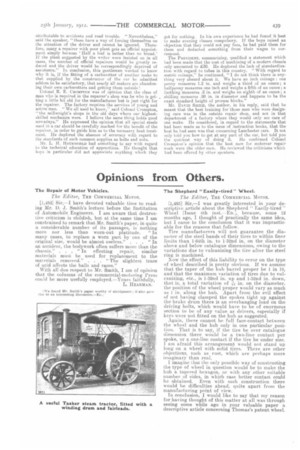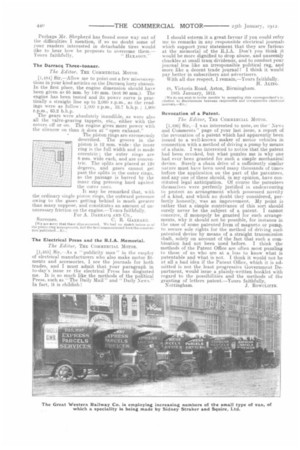Opinions from Others.
Page 17

Page 18

If you've noticed an error in this article please click here to report it so we can fix it.
The Repair of Motor Vehicles.
The Editor, THE COMMERCIAL MOTOR.
[1,482] Sir,—I have devoted valuable time to reading Mr. D. J. Smith's lecture before the Institution of Automobile Engineers. I am aware that destructive criticism is childish, but at the same time I am constrained to remark that Mr. Smith's paper, in quite a considerable number of its passages, is nothing more nor less than worn-out platitude. "In many cases, to replace a worn part by one of the original size, would be almost useless." . . . " In an accident., the bodywork often suffers more than the
chassis." . . . " In effecting repair, similar materials must be used for replacement to the materials removed." . . "The slightest trace of acid affects the balls and races."
With all due respect to Mr. Smith, I am of opinion that the columns of the commercial-motoring Press could be more usefully employed.—Yours faithfully,
L. HEARMAN.
We found Mr. Smith's paper worthy of abridgment ; it also gave rise to an interesting disenssion.—En.;
The Shepherd "Easily-tired" Wheel.
The Editor, THE COMMERCIAL MOTOR.
[1,483] Sir,—I was greatly interested in your descriptive article about the Shepherd " Easily-tired" Wheel [Issue 4th inst.—ED.], because, some 12 months ago, I thought of practically the same idea, but I came to the conclusion that it was impracticable for the reasons that follow.
Tire manufacturers will not guarantee the diameter of the steel bands of their tires to within finer limits than 1-64th in. to 1-32nd in. on the diameter above and below catalogue dimensions, owing to the variations due to vulcanizing the tire after the steel ring is machined.
Now the effect of this liability to error on the type of wheel described is pretty obvious, if we assume that the taper of the hub barrel proper be 1 in 16, and that the maximum variation of tires due to vulcanizing, etc., is 1-32nd in. up and 1-32nd in. down, that is, a total variation of in. on the diameter, the position of the wheel proper would vary as much as 1 in, along the hub. Apart from the evil effect of not having clamped the spokes tight up against the brake drum there is an overhanging load on the driving bolts, which would have to be of enormous section to be of any value as drivers, especially if keys were not fitted on the hub as suggested.
Again, there cannot be full face-contact between the wheel and the hub only in one particular position. That is to say, if the tire be over catalogue dimension there would be a two-line contact per spoke, or a one-line contact if the tire be under size. i am afraid this s.rrangenient would not stand up long on a wheel with solid tires. There are other objections, such as rust, which are perhaps more imaginary than real.
I imagine that the only possible way of constructing the type of wheel in question would be to make the hub a tapered hexagon, or with any other suitable number of sides, in which ease better contact could be obtained. Even with such construction there would he difficulties ahead; quite apart from the manufacturing point of view.
In conclusion, I would like to say that my reason for having thought of this matter at all was through seeing gome while ago in your valuable paper a descriptive article concerning Thomas's patent wheel.
Perhaps Mr. Shepherd has found some way out of the difficulties I mention, if so no doubt some of your readers interested in detachable tires would like to hear how he proposes to overcome them.— Yours faithfully, `` HEXAGON."
The Darracq Three-tonner.
The Editor. THE COMMERCIAL MOTOR.
[1,184] Sir,—Allow me to point out a few misconceptions in your kind articles on the Darracq lorry chassis. In the first place, the engine dimension should have been given as 95 mm. by 190 mm. (not 90 mm.). The engine has been tested and its power curve is practically a straight line up to 2,000 r.p.m., as the readings were as follow : 1,000 r.p.m., 33.7 b.h.p. ; 1,900 r.p.m., 63.2 b.h.p. The gears were absolutely inaudible, as were also all the valve-gearing tappets, etc., either with the covers off or on. The engine gives more power with the silencer on than it does at " open exhaust."
The piston rings are erroneously described. The groove in the piston is 12 rum, wide : the inner ring is the full width and is made eccentric ; the outer rings are 6 mm. wide each, and are concentric. The splits are placed at 120 degrees, and gases cannot get past the splits in the outer rings, as the passage is barred by the inner ring pressing hard against the outer ones.
It may be remarked that, with the ordinary single piston rings, the outward pressure owing to the gases getting behind is much greater than many suppose, and constitutes an amount of unnecessary friction on the engine.—Yours faithfully, For A. DARRACQ AND CO.,
Suresnes. C. R. GARRARD.
[We are sorry that these slips occurred. We had 110 sketch before the piston-ring arrangement, and the text communicated Sore the construction The Electrical Press and the R.I.A. Memorial.
The Editor, THE COMMERCIAL MOTOR.
[1,485] Sir,-As a "-publicity man" in the employ of electrical manufacturers who also make motor fitments and accessories, I see the journals for both trades, and I must admit that your paragraph in to-day's issue re the electrical Press has disgusted me. It is so much like the methods of the political Press, such as " The Daily Mail" and " Daily News," In fact, it is childish ! I should esteem it a great favour if you could refer me to remarks in any responsible electrical journals which support your statement that they are furious at the memorial of the R.I.A. Don't you think it would be more dignified to drop abuse, and unseemly chuckles at small tram dividends and to conduct your journal less like an irresponsible political rag, and more like a decent trade journal'? I think it would pay better in subscribers and advertisers. With all due respect, I remain,—Yours faithfully. ALING.
48, Victoria Road, Aston, Birmingham 18th January, 1912.
We do MA wish to invite trouble by accepting this correspondent's citation to discriminate between responsible and wresponsi ble electrical iournals.—En.
Revocation of a Patent.
The Editor, THE COMMERCIAL MOTOR.
[1086] Sir,---I vas interested to note, on the" News and Comments" page of your last issue, a report of the revocation of a patent which had apparently been issued to a well-known maker of motor vehicles in connection with a method of driving a pump by means of a chain. I was interested to notice that the patent had been revoked, but what puzzles me is why one had ever been granted for such a simple mechanical device. Surely a chain drive of a sufficiently similar nature must have been used many thousands of times before the application on the part of the patentees, and any one of these should, in my opinion, have constituted legal anticipation. Of course the patentees themselves were perfectly justified in endeavouring to protect an arrangement which possessed novelty of a kind, and which DO doubt they considered, perfectly honestly, was an improvement. My point is rather that a simple contrivance of this sort should surely never be the subject of a patent.. I cannot conceive, if monopoly be granted for such arrangements, why it should not be possible, for instance in the case of some patented form of magneto or pump, to secure sole rights for the method of driving such patented device by means of a straight transmission shaft, solely on account of the fact that such a combination had not been used before. I think the methods of the Patent Office are often most puzzling to those of us who are at a loss to know what is patentable and what is not. I think it would not be at all a bad idea if the Patent Office, which it is admitted is not the least progressive Government Department, would issue a plainly-written booklet with regard to the possibilities and the methods of the granting of letters patent.—Yours faithfully, Nottingham. J. ROWCLIFFR.






















